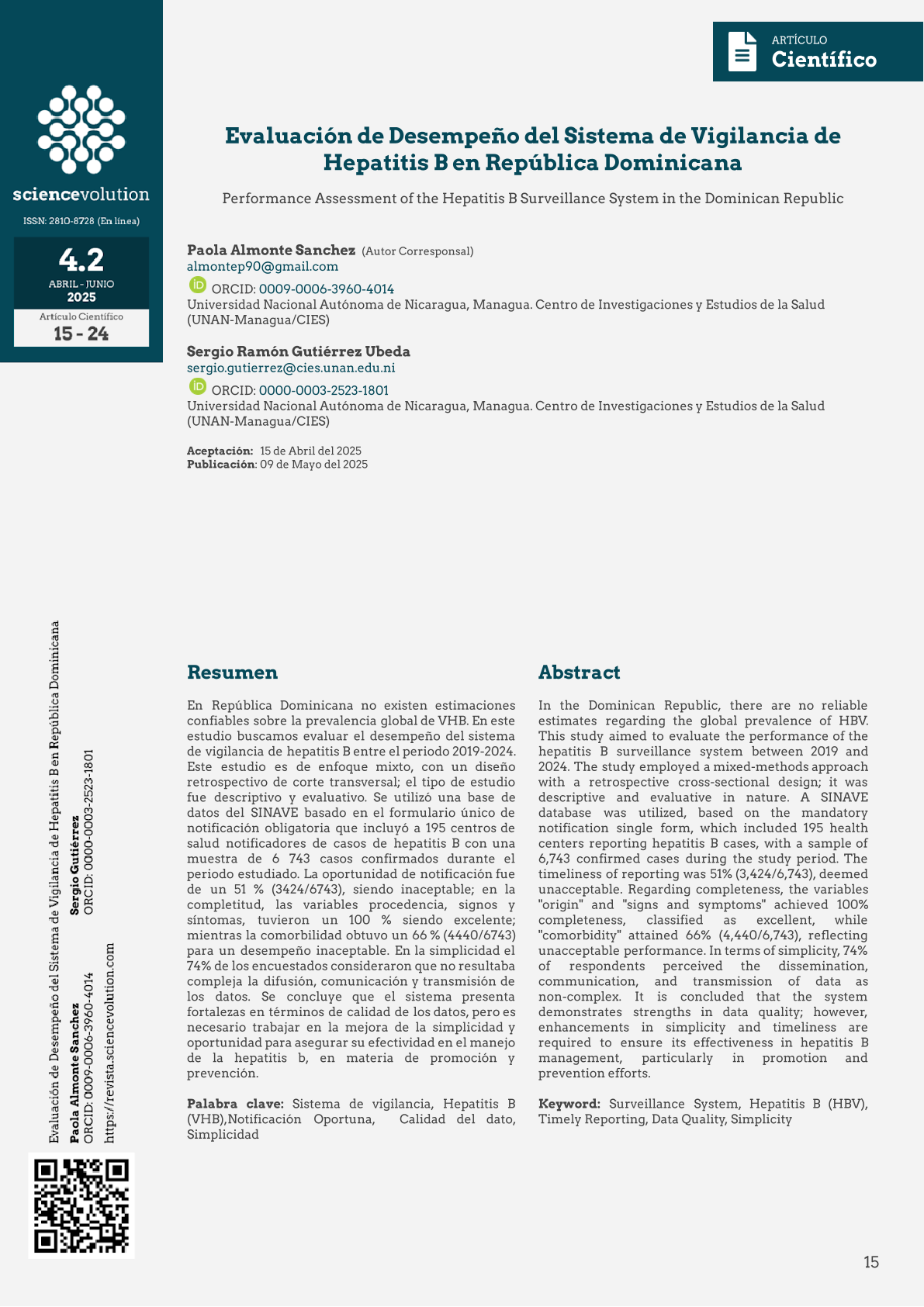Abstract
In the Dominican Republic, there are no reliable estimates regarding the global prevalence of HBV. This study aimed to evaluate the performance of the hepatitis B surveillance system between 2019 and 2024. The study employed a mixed-methods approach with a retrospective cross-sectional design; it was descriptive and evaluative in nature. A SINAVE database was utilized, based on the mandatory notification single form, which included 195 health centers reporting hepatitis B cases, with a sample of 6,743 confirmed cases during the study period. The timeliness of reporting was 51% (3,424/6,743), deemed unacceptable. Regarding completeness, the variables "origin" and "signs and symptoms" achieved 100% completeness, classified as excellent, while "comorbidity" attained 66% (4,440/6,743), reflecting unacceptable performance. In terms of simplicity, 74% of respondents perceived the dissemination, communication, and transmission of data as non-complex. It is concluded that the system demonstrates strengths in data quality; however, enhancements in simplicity and timeliness are required to ensure its effectiveness in hepatitis B management, particularly in promotion and prevention efforts.
References
Fernandez, C. (2024). Hepatitis B y C tienen mayor potencial de convertirse en enfermedades crónicas. Diario Libre. https://www.diariolibre.com/actualidad/salud/2024/09/04/hepatitis-b-y-c-tienen-mayor-potencial-de-convertirse-en-cronicas/2838574
Fundación Mayo para la Educación y la Investigación Médica. (2025). Hepatitis B: Síntomas y causas. https://www.mayoclinic.org/es/diseases-conditions/hepatitis-b/symptoms-causes/syc-20366802
García de la Torre, G., Linares, N., Lutzow Steiner, M. Á., & Valdés Hernández, J. (2012). Vigilancia epidemiológica. En A. R. Villa Romero, L. Moreno Altamirano, & G. S. García de la Torre (Eds.), Epidemiología y estadística en salud pública (pp. 1-27). McGraw Hill. https://accessmedicina.mhmedical.com/content.aspx?bookid=1464§ionid=101050673
Gran S, J. I. & Soza, R. (2020). Hepatitis B Cronica. Gastroenterol, Latinoam, 79-84. https://gastrolat.org/DOI/PDF/10.46613/gastrolat202002-04.pdf.
Joseph, L., Agarwal, V., Raju, U., Mavaji, A., & Rajkumar, P. (2021). Perception of Hospital Accreditation Impact among Quality Management Professionals in India: A Survey-Based Multicenter Study. Global Journal on Quality and Safety in Healthcare, 4(2), 58–64. https://doi.org/10.36401/jqsh-20-44
Manzano Vela, M. P. (2024). Prevalencia y epidemiología de la hepatitis A en niños menores de 6 años: Una revisión sistemática de la literatura. Revista Científica De Salud Y Desarrollo Humano , 5(2), 69–100. https://doi.org/10.61368/r.s.d.h.v5i2.122
Mercuriali, L., Oliveras, L., Marí, M., Gómez, A., Montalvo, T., García-Rodríguez, A., Pérez, G., & Villalbí, J. R. (2022). Un sistema de vigilancia de salud pública para el cambio climático en las ciudades. Gaceta Sanitaria, 36(3), 283–286. https://doi.org/10.1016/j.gaceta.2021.01.003
Ministerio de Salud Pública y Asistencia Social. (2020). Resolución 000004. Declaración de actualización de enfermedades y eventos de notificación obligatoria del sistema nacional de salud, y modifica la resolución 000004-13. Santo Domingo de Guzman, Santo Domingo, Republica Dominicana. https://repositorio.msp.gob.do/bitstream/handle/123456789/1689/Resolucion-000004%20del%2002-03-2020%20Reporte%20Obligatorio%20De%20Enfermedades%20Y%20Eventos%20Priorizados.pdf?sequence=1&isAllowed=y
Organización de las Naciones Unidas. (2023). Informe de los Objetivos de Desarrollo Sostenible: Edición Especial https://unstats.un.org/sdgs/report/2023/The-Sustainable-Development-Goals-Report-2023_Spanish.pdf
Organización Mundial de la Salud. (2024). Hepatitis B. https://www.who.int/es/news-room/fact-sheets/detail/hepatitis-b
Organización Panamericana de la Salud (2017). Módulos de principios de epidemiología para el control de enfermedades (MOPECE). Módulo 6: Control de enfermedades en la población. https://iris.paho.org/handle/10665.2/55844
Perez, A., & Ureña, E. (2023). Evaluación del sistema de vigilancia tosferina, República Dominicana, 2016-2021. Training Programs in Epidemiology and Public Health Interventions Network (TEPHINET). https://www.tephinet.org/learning/fead/evaluacion-del-sistema-de-vigilancia-tosferina-republica-dominicana-20216-2021
Salomón, M., & Pérez, L. (2023). Evaluación del sistema de vigilancia Lepra, República Dominicana, 2017-2021. Training Programs in Epidemiology And Public Health Interventions Network (TELEPHINET). https://www.tephinet.org/learning/fead/evaluacion-del-sistema-de-vigilancia-lepra-republica-dominicana-2017-2021
Tapia, L., Peña, P., Manosalvas, L., & Paulino-Ramírez, R. (2019). Modelo de cascada de atención para la co-infección de las hepatitis virales para el cuidado continuo en personas con VIH/Sida. Ciencia y Salud, 3(3), 35–41. https://revistas.intec.edu.do/index.php/cisa/article/view/1542
Vargas Córdoba, J. A. (2023). Perspectivas compartidas en el manejo de la hepatitis ocupacional a nivel mundial. PIENSO en Latinoamérica 5(14). https://www.piensoenlatinoamerica.org/storage/pdf-articles/1692117438-5%20Art%C3%ADculo%20original.pdf.
Zapata M., (2018). Importancia del sistema GRD para alcanzar la eficiencia hospitalaria. Revista Médica Clínica Las Condes, 29 (3) 347–352. https://doi.org/10.1016/j.rmclc.2018.04.010

This work is licensed under a Creative Commons Attribution-NonCommercial-NoDerivatives 4.0 International License.
Copyright (c) 2025 Paola Almonte Sanchez, Sergio Ramón Gutiérrez Ubeda

